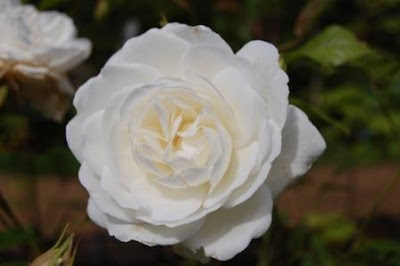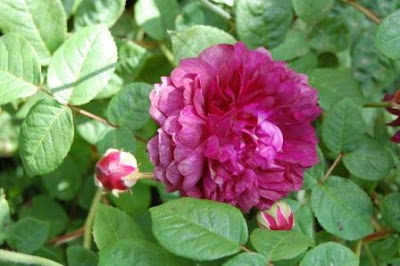At this time of the year the rose is one of the most stunning for scent and the array of colours. However not everyone has great success so here are some tips to acheive the perfect rose.

Pests
At the first sign of aphids don’t panic and reach for the spray – chances are you will kill off the beneficial insects also, such as ladybirds, which will eat them for you. If you can’t bear to ignore them, smudge off with your fingers, blast off with a hose, or at last resort use soapy water.
Blackspot
If you have a persistent black spot problem, apply a weak drench solution of either Jeyes or Armilitox in soil around plants over winter to kill off blackspot spores. Add sulphur chips to soil at the base of the plant.
Pick off any infected leaves as soon as you see them. Do not put on your compost heap. Collect fallen leaves and either burn or put in rubbish
Always water at the base NOT on the leaves and water in the morning so leaves have chance to dry.
If you have a persistent blackspot problem, you can use Bordeaux mixture before leaves open, or treat leaves with copper fungicide.
Grow varieties that have some black spot resistance.
A completely organic method for treating blackspot is to spray the leaves with diluted skimmed milk. This forms an invisible fungus which prevents the black spot fungus forming.
Remember: Roseclear is poisonous to bees.
The Secret Garden, May 09
Roses – Tips for success.
Planting
Roses like clay soil. If your soil is chalky, shallow or sandy you will need to improve it with well-rotted manure, compost etc. Roses prefer slightly acidic soil (pH 6-6.5). They also like good drainage. Choose a sunny (but not baking hot & dry) spot with good air flow.
Don’t overcrowd roses –allow space between plants for airflow, and under plant with companion plants that will attract beneficial insects which will eat aphids. Suggestions include hardy geraniums, chives, lavender. Avoid root competition from large shrubs and trees.
It is not advisable to plant a rose where a rose was planted previously as this can cause Rose Replant Disease. If you wish to plant the rose in the exact same location you must replace all the soil in the planting hole. An alternative is to plant the rose in a biodegradable cardboard box filled with fresh topsoil or John Innes No.3.
Planting
Roses like clay soil. If your soil is chalky, shallow or sandy you will need to improve it with well-rotted manure, compost etc. Roses prefer slightly acidic soil (pH 6-6.5). They also like good drainage. Choose a sunny (but not baking hot & dry) spot with good air flow.
Don’t overcrowd roses –allow space between plants for airflow, and under plant with companion plants that will attract beneficial insects which will eat aphids. Suggestions include hardy geraniums, chives, lavender. Avoid root competition from large shrubs and trees.
It is not advisable to plant a rose where a rose was planted previously as this can cause Rose Replant Disease. If you wish to plant the rose in the exact same location you must replace all the soil in the planting hole. An alternative is to plant the rose in a biodegradable cardboard box filled with fresh topsoil or John Innes No.3.
Maintenance
Mulch in autumn and again in spring, with organic material (manure, compost, leaf mould or bark).
Feed in spring and again after first flowers appear. Seaweed increases plant vigour and resistance to disease. Avoid feeds that have a high nitrogen content as these encourage sappy growth (a blackfly magnet).
Prune your roses in early spring. Clean sloping cuts above an outward facing bud and remove all dead and diseased wood. You can also prune back roses by third in autumn to prevent windrock, also taking out any weak or diseased growth. Keep a nice open centre to the rose to encourage air flow.
Always water at the base NOT on the leaves and water in the morning so leaves have chance to dry.

Pests
At the first sign of aphids don’t panic and reach for the spray – chances are you will kill off the beneficial insects also, such as ladybirds, which will eat them for you. If you can’t bear to ignore them, smudge off with your fingers, blast off with a hose, or at last resort use soapy water.
Blackspot
If you have a persistent black spot problem, apply a weak drench solution of either Jeyes or Armilitox in soil around plants over winter to kill off blackspot spores. Add sulphur chips to soil at the base of the plant.
Pick off any infected leaves as soon as you see them. Do not put on your compost heap. Collect fallen leaves and either burn or put in rubbish
Always water at the base NOT on the leaves and water in the morning so leaves have chance to dry.
If you have a persistent blackspot problem, you can use Bordeaux mixture before leaves open, or treat leaves with copper fungicide.
Grow varieties that have some black spot resistance.
A completely organic method for treating blackspot is to spray the leaves with diluted skimmed milk. This forms an invisible fungus which prevents the black spot fungus forming.
Remember: Roseclear is poisonous to bees.
The Secret Garden, May 09


